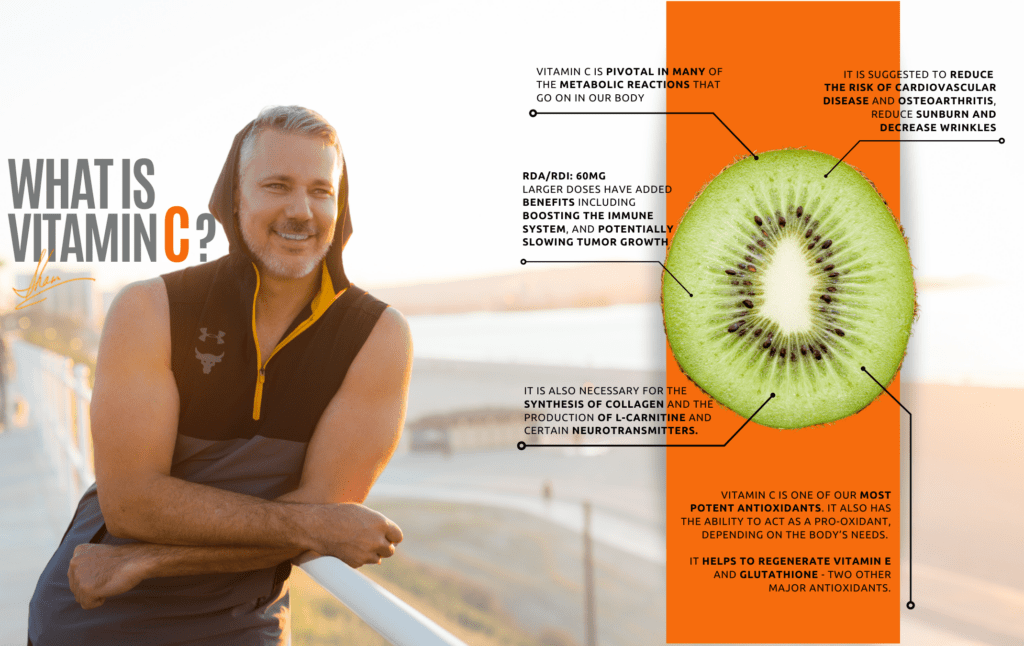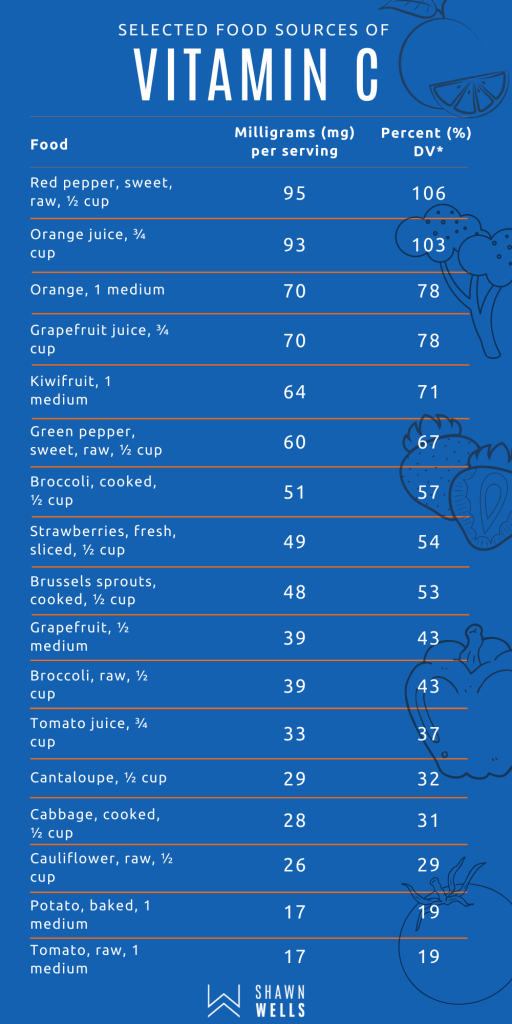Chemical name: Ascorbic acid
- It is water soluble.
- Deficiency: may cause megaloblastic anemia, scurvy, connective tissue deterioration
- Good sources include: fresh fruit and vegetables – the Kakadu plum and the camu camu fruit have the highest vitamin C contents of all foods, with liver, red & yellow peppers, kiwi fruit & guava having high values too.
One of the first vitamins that people sweep off the shelves at the drug store when they’re battling a cold, cough or flu is Vitamin C. It is unique in the fact that the human body cannot make it, making it an essential compound we need to either get from food or supplement with. Interestingly, dogs have the ability to produce vitamin C for their needs, while we can’t. As another example, vitamin D can be made in the body when we’re exposed to sunlight, but only in small amounts, so supplementing with it is often necessary. It is very popular due to its low price, its safety and its antioxidant properties.
WHAT DOES IT DO?
The short answer: A LOT. The fact that a deficiency can have so many negative implications on health backs its essentiality in our diet. Vitamin C is pivotal in many of the metabolic reactions that keep our bodies functioning because of its role as a cofactor, or a ‘helping molecule’, for many of these biochemical processes. It is suggested to reduce the risk of cardiovascular disease and osteoarthritis, reduce sunburn and decreasing wrinkles! The biosynthesis of collagen, which is a major component of bones, ligaments, tendons and cartilage, is dependent on vitamin C, making it essential for health hair, teeth, skin, joints and bones. It is also necessary for the production of L-carnitine and major neurotransmitters.
The main role of vitamin C is an antioxidant. It is our most universal antioxidant and by sequestering free-radicals in the body, it fights off the dreaded process called oxidation, that we all know is fundamental to poor health. Interestingly, it also has the ability of acting as a pro-oxidant – depending on what the body needs. Even more, it has been shown to regenerate other antioxidants in the body such as vitamin E. Oxidative damage is an underlying cause of several diseases making vitamin C’s antioxidant capabilities powerful in preventing and even treating numerous health conditions.
Most well known is vitamins C’s impact on the immune system. We know it is important because we see deficiencies in the vitamin in those with infections or who are immuno-compromised. It is known to aid in the production of immune cells (phagocytes and T-cells) and can help ward off respiratory infections to some degree. Due to its antioxidant effect, it protects our immune cells which actually produce a lot of reactive oxygen species (ROS), especially lymphocytes. The ROS can be great for warding off bacteria and viruses but can also harm the immune cell themselves, so vitamin C protects them to a degree.
There is evidence that vitamin C of at least 200mg/day could reduce the duration of the common cold by about one day, and given its low cost and safety, it may be worthwhile to supplement when you have a cold. Hundreds of studies have examined the effect vitamin C has on the immune system and a recent meta-analysis indicated that “routine vitamin C supplementation is not justified” for the general population, but could be useful for those who do regular intense physical exercise.
With that said, vitamin C does not exactly boost the immune system, but actually supports it by protecting the immune cells and improving their lifespan and ability to fight against infections.
VITAMIN C DEFICIENCY
Most well known is scurvy; a pathological condition that leads to blood vessel fragility and poor connective tissue production. Symptoms include fatigue, malaise and inflamed gums. Inadequate vitamin C causes collagen synthesis to become impaired, leading to joint pain, poor wound healing, and hyperkeratosis.
Deficiency is uncommon but can still occur in people who have limited food variety. Smokers are at higher risk to vitamin C deficiency, and even those who are exposed to secondhand smoke!
If you’re someone who gets sick regularly, then you may have a deficiency in vitamin C.
DOSE
The Recommended Daily Intake (RDI) of vitamin C is 60mg. This amount can easily be obtained from the diet. In some cases, people take much larger doses between 2,000mg and 3,000mg per day, generally to boost the immune system and reduce the duration of a cold or flu. High doses like this however can cause diarrhea, gastric distress, fatigue, headaches, insomnia and heartburn in some people.
Even if you don’t have any of these side effects, taking 3,000mg a day can just be a waste of money. The more you supplement, the more you speed up your metabolism of vitamin C and so you may want to slowly decrease your intake by 500mg a week if you are taking such high doses. A dose of 500mg-1,000mg daily is generally a good target.
FOOD SOURCES
Many fruits and vegetables have vitamin C, with the Kakadu plum and camu camu fruit having the highest content. Guavas, strawberries and red and yellow bell peppers are amongst the highest. Liver is also rich in vitamin C. You can find a detailed list of foods containing vitamin C here.
Keep foods containing vitamin C refrigerated and covered as often as possible and try not to cook them at high heats as this deteriorates the vitamin content significantly. Your vitamin needs should primarily be met by eating a well-formulated, whole foods-based diet, but in the modern world where we have mass-produced fruits and vegetables that generally lack sufficient amounts of the nutrients we require, supplementation can be very helpful.
SUPPLEMENTS
Vitamin C is found in most multivitamin products and other immune-boosting formulations, but it is also found as a single ingredient. A review concluded that consistent daily supplementation with vitamins C was more effective at reducing the duration and severity of a cold compared to taking it at the onset of symptoms. So, it may be worthwhile working on incorporating enough vitamin C into your diet, or considering some of the supplements you can buy.
Most supplements contain vitamin C in the form of ascorbic acid which in contrast to some supplemental vitamins has similar bioavailability to the ascorbic acid found in food. You may also find buffered forms of vitamin C which are attached to a mineral (like calcium, magnesium, sodium, etc.) such as calcium ascorbate and sodium ascorbate which buffers the vitamin C. . Adding these minerals results in a less acidic form of vitamin C, tempering its potential irritating effect on the gut and enables you to take slightly higher doses and you get the added benefit of getting in some minerals.
Simple ascorbic acid is the cheapest and obviously preferred, but forms that are buffered with minerals, as explained above, may be more tolerable by the gut for certain people.
Liposomal vitamin C is another form that is slightly superior to regular vitamin C and we are seeing in a lot more products today. Here, the vitamin C is encapsulated in liposomes, which are like tiny bubbles that accelerate the absorption of the vitamin across the gut wall and into the bloodstream. Above all, intravenous (IV) vitamin C proves to have the best bioavailability in the body, but due to the associated risks of administering anything intravenously, it is not used frequently.
Some supplements combine vitamin C with bioflavonoids – natural substances found with vitamin C that enhance its antioxidant power. They are essentially antioxidants themselves and help to fight free radicals and reduce sources of inflammation and oxidation. Research has shown that when enriched with bioflavonoids, there is no obvious benefit in raising the levels of vitamin C in the blood over any particular source, but the bioflavonoids may help vitamin C carry out its incredible antioxidant capabilities within the body.
Because we require these naturally occurring additional compounds (cofactors and enzymes) to be present for vitamin C to carry out its biochemical reactions properly, a process used to make vitamins in a lab known as fermentation is preferable, as it involves all of the compounds found with vitamin C in nature, making it absorbed more readily by the body. Fermentation is a natural process that labs can use to make a compound, versus synthetically producing a compound from chemicals.
JOINT REPAIR
When supplementing with collagen (or gelatin) to improve joint health post injury, for example, it is important to add at least 50mg of vitamin C with the collagen to support the collagen biosynthesis within the body.
A NOTE ON CANCER TREATMENT
Early studies have suggested that high dose vitamin C could improve the quality of life and increase survival time of cancer patients. Some studies showed no improvement. The conflicting results could be explained by the fact that the route of vitamin C administration affects plasma vitamin C concentrations differently. High oral doses can raise plasma levels to about 220 micromol/L, while IV (intravenous) administration can increase plasma concentrations to above 26,000 micromol/L! These high concentrations are cytotoxic to tumor cells. In this case, vitamin C acts as a pro-oxidant (as opposed to an antioxidant), killing tumor cells. Based on these findings, high-dose IV vitamin C is supported as a drug to treat cancer.
A NOTE ON COVID-19
Due to the growing evidence of the low risk and the benefits of IV vitamin C, The American Association of Naturopathic Physicians released a statement encouraging the use of IV Vitamin C in patients who are infected with the Coronavirus. The statement says, “healthcare practitioners on the front lines of treating moderate to severe cases of COVID-19 to utilize intravenous Vitamin C (IVC, also known as IV Ascorbic Acid) as an adjunctive measure in the care of their patients.”
Additionally, according to the Chinese Expert Panel, the treatment actually decreased the duration of stay in the hospital by 3 – 5 days compared to patients who didn’t receive vitamin C IV. This is a low cost and effective treatment that could significantly free up space in hospitals. However, clinical trials are still being carried out and the safety and efficacy is not one hundred percent clear as of now, even though numerous case studies support it.
Any of the statements above should not be considered a replacement for recommendations from your doctor for the treatment of cancer or COVID-19, and you should consult your doctor before pursuing any IV treatment.
I hope this gives you more insight to this incredible vitamin. Be sure to be wary of the scams out there while we’re fighting off the Coronavirus – you’ll be surprised how desperate people are to make money! Please let me know if you have any questions in the comments! Check out my Instagram page to see the latest on Vitamin C, and my personal opinions, as well as for more content on ingredients coming up!
Disclaimer: I am not a medical doctor, and all of the information above is for information purposes only. Consult with your doctor before implementing any of the above.
Original blog may be found directly on Shawn's site: https://shawnwells.com/blog/vitamin-c/
Stay connected with Shawn Wells:
- Instagram @ingredientologist
- Facebook /Ingredientologist
- LinkedIn /zonehalo
- shawnwells.com
Want to be featured by ICON Meals? Submit your stories to info@iconmeals.com or send us a DM on IG or Facebook!
REFERENCES
https://www.medicalnewstoday.com/articles/195878#types
https://ods.od.nih.gov/factsheets/VitaminC-HealthProfessional/
Hemilä H, Chalker E. Vitamin C for preventing and treating the common cold. Cochrane Database of Systematic Reviews 2013, Issue 1. Art. No.: CD000980. DOI: 10.1002/14651858.CD000980.pub4.
https://www.livescience.com/coronavirus-vitamin-c-myth.html
DePhillipo NN, Aman ZS, Kennedy MI, Begley JP, Moatshe G, LaPrade RF. Efficacy of Vitamin C Supplementation on Collagen Synthesis and Oxidative Stress After Musculoskeletal Injuries: A Systematic Review. Orthop J Sports Med. 2018;6(10):2325967118804544. Published 2018 Oct 25. doi:10.1177/2325967118804544
https://organixx.com/vitamins-to-boost-your-immune-system/#summary
https://www.ncbi.nlm.nih.gov/pmc/articles/PMC4915787/



